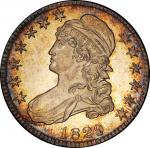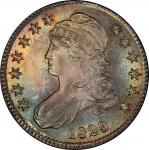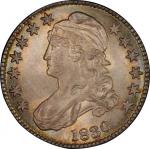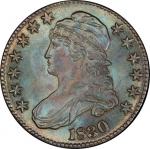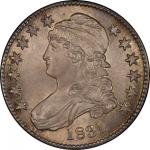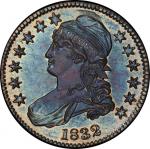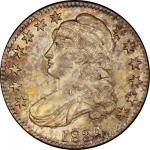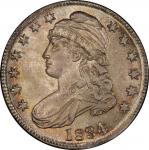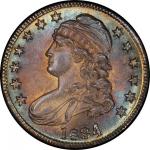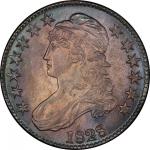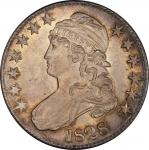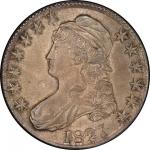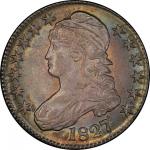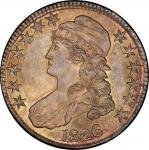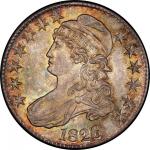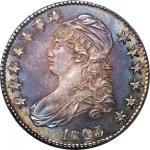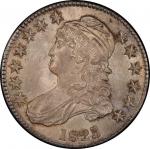“Monday 28 Dec. Visited US Mint. The establishment is carried on in a very mean house. A new building, it is said, is now building for its reception.” — Benjamin Leonard Covington Wailes of Natchez, Mississippi, “A View of Philadelphia in 1829,” by John Hebron Moore, The Pennsylvania Magazine of History and Biography, July 1954 With spectacular reflectivity and extraordinary toning of bright blue, violet, and gold, this example towers above every other example of this popular overdate variety based upon pure aesthetics. The overdate is easily seen at this grade, showing repunching on all four date digits, mostly to the north on 18, to the south on 29. This variety would be more correctly described as 1829/1827. The repunching on the 2 is as bold or bolder than that on the 9. Central detail is good on both sides, though the top of Liberty’s cap is a bit flat, as are TA of STATES and the top of the characters in the denomination. The stars nearly all have their centers, excepting stars 1 and 8. Technically well preserved, the fields show some trivial hairlines but no significant marks, though a few tiny contact marks may be noted on Liberty’s portrait. A shallow abrasion blends into the field above Liberty’s bust. Areas of frost surround Liberty’s bust and profile, and some of the lower portion of the eagle has been polished away on the reverse die following a clash. The only remaining trace of die clashing is a short line above the wing left of the eagle. On Christmas Day 1829, after a riverboat trip on the Mississippi and Ohio from Natchez to Wheeling, an overland ride to Baltimore, and another leg by water from there, B.L.C. Wailes and his wife arrived in Philadelphia for some sightseeing. A few days later, after passing some time at Philadelphia’s market (“the beef is unrivaled in the world”), Wailes spent most of his morning on December 28th visiting the United States Mint. Like Prince Bernhard in 1826, Wailes documented his visit, jotting down an extraordinarily detailed commentary in his personal diary. First published in 1954, excerpts from Wailes’ journal were incorporated into Don Taxay’s The U.S. Mint and Coinage in 1966, but the original source remains too little known by numismatists. Wailes witnessed the same processes as Bernhard: rolling ingots into stock, punching planchets from the stock with “a bit (or gouge, or punch) driven by a powerful screw,” weighing, and coining. The screw press, in Wailes’ estimation, was “a very powerful, ingenious, simple (tho very perfect) piece of machinery.” It consists (like the cutting machine) of a very powerful upright screw, to the top of which is affixed a heavy & strong lever worked with great apparent ease by one man at each end, & by which the screw is made to make about one fourth of a revolution & returning instantly to its former position. At the lower end of the screw is affixed the die which gives the impression on the upper side, & immediately under it is the die containing the impression for the reverse of the coin ... the stamped coin is struck out of its place & conveyed into a box by a spout (or conductor) as the screw rises, and another unstamped coin takes it place, & the screw comes down again. Half dollars, dimes, and half dimes were delivered to the Treasurer of the Mint on December 31, 1829, and Wailes may have seen any or all of these denominations being struck. His description of “a pair of nippers (which gives the milling or impression on the edges)” indicates he saw dimes, half dimes, quarter eagles, or half eagles, all coins that received their edge reeding at the moment of coining. Half dollars received their edge device in the edge mill or Castaing machine until 1836. With its dazzling visual appeal and place atop the PCGS Population Report, no one will question Stephen Herrman’s judgment that this specimen is the finest known of the variety. The two 1829/7 varieties, O-101 and O-102, share a common obverse; both are eagerly sought out by major variety collectors. This is the only PCGS MS-66 example of either die variety of the 1829/7 overdate to be offered at auction. PCGS# 39807. NGC ID: 24FT.

